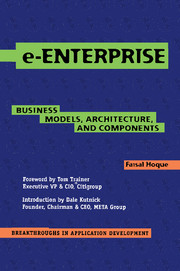Book contents
- Frontmatter
- About the Author
- Contents
- Dedication
- Foreword
- Acknowledgments
- Introduction
- PART 1 The e-Enterprise
- PART 2 Business and Application Models
- PART 3 e-Enterprise Methodology and Architecture
- PART 4 Enabling Components
- Chapter 7 e-Enterprise Business Components
- Chapter 8 e-Enterprise Technology Components
- Afterword: Who Will Be the Great e-Enterprises?
- References
- Index
Chapter 7 - e-Enterprise Business Components
Published online by Cambridge University Press: 20 May 2010
- Frontmatter
- About the Author
- Contents
- Dedication
- Foreword
- Acknowledgments
- Introduction
- PART 1 The e-Enterprise
- PART 2 Business and Application Models
- PART 3 e-Enterprise Methodology and Architecture
- PART 4 Enabling Components
- Chapter 7 e-Enterprise Business Components
- Chapter 8 e-Enterprise Technology Components
- Afterword: Who Will Be the Great e-Enterprises?
- References
- Index
Summary
In the Internet Economy the big won't beat the small—the fast will beat the slow.
—John Chambers, President and CEO, Cisco SystemsThe real driving factors behind the new economy are flexibility, agility, and time to market. Obviously, this means speeding the desired e-Applications to market in the first place. However, speed also involves how quickly your company can respond to market changes by rolling out new, iterative versions of e-Enterprise platforms. Sometimes emerging technology standards that enable exchange of information between partners and stakeholders drive these changes. Sometimes they are driven by shifts in the external business landscape such as new market opportunities. Still other times they result from concerted analysis and process engineering driven by internal corporate forces.
As discussed in Chapters 5 and 6, the key to enabling this perpetual business, application, and technology change is a reusable repository of operating models and infrastructure that embody the common functionality shared by multiple e-Applications. Therefore, this repository must store the high-level business services that provide cross-functional business/application functionality and the technology components that aid in producing the underlying technology infrastructure. These high-level business services are known as application or business components. The combination of business and technology components provides the backbone not only for the repository, but also for the iterative design and deployment methodology that is integral to the concept of the e-Enterprise.
Although the concept of technology components has been around for some time, the concept of business components is still in its infancy.
- Type
- Chapter
- Information
- e-EnterpriseBusiness Models, Architecture, and Components, pp. 205 - 230Publisher: Cambridge University PressPrint publication year: 2000



